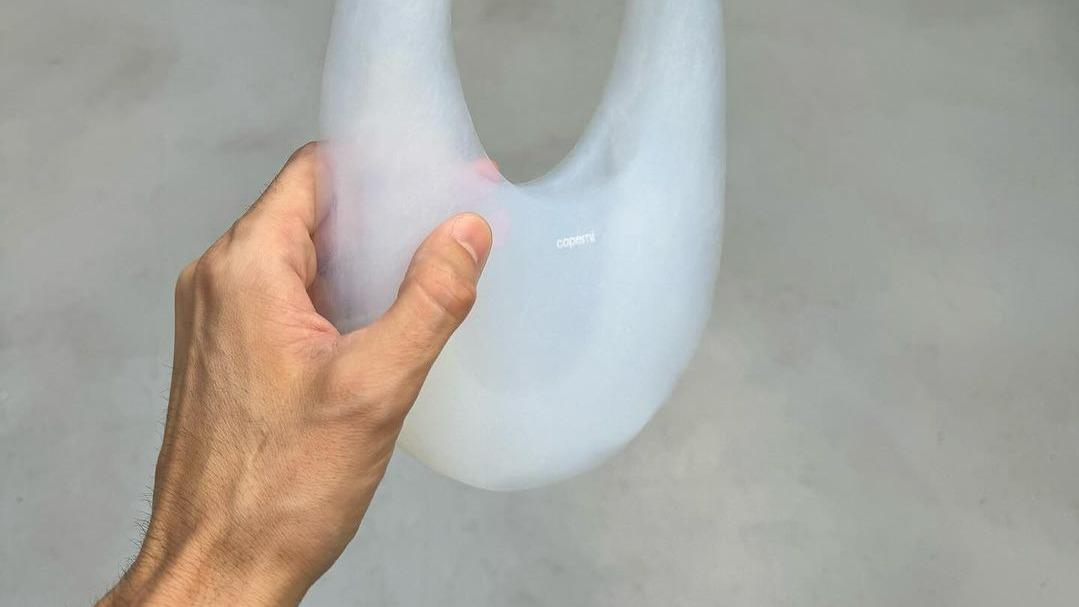Gema, Toñi and Míriam are three residents of Móstoles who began to get together in the cafeteria of the Centro de Arte Dos de Mayo (CA2M), the contemporary art museum located in their town, to chat while sharing crochet work.
Five years ago, the museum itself decided to give an institutional twist to its activity.
He reserved a table for them every Wednesday from 11 a.m. to 1 p.m. and dedicated an ad hoc set consisting of a tapestry by the artist
Teresa Lanceta
,
belonging to his collection.
It is the headquarters of Tejiendo Móstoles, a group that has been growing - just before the pandemic there were more than 20 women - at the same time as its connection with the art center.
“Here they have interacted with our education team, and also with Teresa herself,” explains Manuel Segade, director of CA2M.
In a way, it is Tejiendo Móstoles' own colleagues who have inspired the
exhibition
Collection XVIII: Textil
,
which has just opened in the center.
The first part of the title places us before the eighteenth exhibition that is made from the funds of the CA2M and Fundación ARCO collections.
And the second refers to the fact that all its pieces are made using different materials and textile techniques.
As the museum explains when contextualizing the exhibition, textile production has practically always existed as a cultural activity (anthropological research attributes it up to 500,000 years ago), but largely due to its association with the domestic and feminine , has not enjoyed a high position within the artistic hierarchies.
For example, it was an essential pillar in the society of ancient Greece, but at the same time negative connotations were attributed to it such as trickery cunning
(Penelope
unweaving the knitting every night during the day to break her promise of marriage) or the competition that ends in punitive revenge
(Arachne
, the weaver who boasted of being more skilled than the goddess Athena and who ended up turning into a spider as punishment for her pride).
Without abandoning Greek mythology, the tapestry would also have served
Filomela,
raped and mutilated by her brother-in-law Tereo, to narrate the atrocities to which she had been subjected and denounce them to her sister Procne.
With this, we find in weaving and embroidery the antecedents for a revolutionary potential that perhaps has not been sufficiently exploited as a field of study, beyond the feminist art historian Roszika Parker (the book
The Revolutionary Stitch,
published in 1989 ).
Segade and Tania Pardo –deputy director of CA2M–, as curators of the exhibition, walk this same route: “The history of textiles has always been associated with social transformation, with the silk route, the wool trade in Flanders or the industrial revolution, which began in the looms ”, they explain.
"But also in the sixties of last century the Second Wave of Feminism incorporated it into its discourse from a perspective of political vindication".
During the 20th century, several male creators used tapestries as a support for their work, with results especially recognized in Matisse, Miró, Klee, Kandinsky or Vasarely.
But it is also true that, except for
Alighiero Boetti,
in few cases it was done in a systematic way to the point of defining an entire career, as happened with the artist
Anni Albers.
A member of the Bauhaus, as a woman she was initially forbidden to access
hard
disciplines
(literally and figuratively) such as glass or metallurgy, and she soon opted for
soft
media
.
One can also cite the example of
Sonia Delaunay,
one of the pioneers of pictorial abstraction, who also achieved notable success with her clothing.
To market them, he opened several stores in Spain before sweeping them away in Paris, the fashion capital of the world.
"It is likely that she found this textile work even more important" than the one she captured on the canvases, Segade argues.
"Then, that her painting has been considered as the main activity and the other as a kind of
hobby
is something alien to her."
Although only three of the 25 pieces in the exhibition are made by men, one of them is in charge of opening the fire.
It is a small and exquisite tapestry by the Catalan Josep Grau-Garriga (1928-2011), who like Albers made this technique his main means of expression, while helping to renew it with his own works or collaborating on works signed by Miró or Tàpies .
Later we will find other more or less canonical tapestries.
Caroline Achaintre
and
Teresa
Lanceta
stand out
,
the latter precisely with the work that served as the background to the meetings of the Tejiendo Móstoles collective, carried out according to the techniques learned from the weavers of the Middle Atlas.
But there are more heterodox cases.
In several of them, textiles become the ideal medium to materialize political messages and denunciation in the style of Filomela.
More literally with the Mexican Teresa Margolles - embroidered with gold wire on a cloth stained with the blood of a victim of violence - but also with Asunción Molinos Gordo, Nohemí Pérez, Cristina Lucas or Yinka Shonibare.
The scenographic appears in the self-talk of
Laure Prouvost,
who invents a motley universe before which we could spend hours deciphering references.
On other occasions, ironic winks are made to the pictorial gesture (Arturo Herrera, Belén Rodríguez, Julia Huete or Mercedes Azpilicueta) or there is a tendency towards the sculptural, as in the pieces by Nora Aurrekoetxea and Carolina Caycedo, or in that by
Sonia Navarro,
called
Atocha.
Because of its name and its black color, it could be thought that it pays homage to the victims of the 2004 attacks. Actually,
atocha
is the vulgar name of the esparto plant, and the work is made of braided esparto, as the esparto was sown profusely. Madrid street.
Hence it received its current name.
At the present time there seems to be a certain vindication of textile art.
Only in Madrid, we can see these days the fascinating sculptural pieces by
Aurèlia Muñoz
(Barcelona, 1026-2011), a historical artist rescued by the José de la Mano gallery, while Galería Nueva presents
Dissenting Textiles, an
exhibition by Equatorial Guinean Pocho Guimaraes.
But this was not always so.
Pardo and Segade subvert the discredit that activities associated with the feminine and the domestic have suffered throughout history.
That is why they have coined a term that collects all this set of techniques and skills that the exhibition honors:
marujos knowledge.
"It refers to all this knowledge that is transmitted through affective codes, which are collective and have a healing element, to which attention is now paid but have been relegated for a long time", they define.
The exhibition conveys something of this spirit through the pleasant sensation it leaves at the exit, enhanced by the warm lighting and the tactile and sensual quality of many of the pieces.
Because the least that should be expected of a revolution is that it be able to clothe us.

/cloudfront-eu-central-1.images.arcpublishing.com/prisa/QI454FORQBEYTKBE4YF7DJXHOE.png)




/cloudfront-eu-central-1.images.arcpublishing.com/prisa/V6VLZTYXJFDXBNZJHIT2VDJVFY.png)







